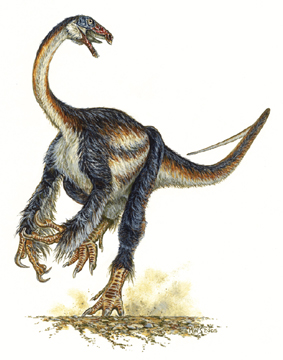 A few years
ago, Utah State Paleontologist James Kirkland saw an unusual specimen for sale
at a fossil and gem show. Months later, he finally reached the person who had
collected the fossil and took a trip to the collection site.
A few years
ago, Utah State Paleontologist James Kirkland saw an unusual specimen for sale
at a fossil and gem show. Months later, he finally reached the person who had
collected the fossil and took a trip to the collection site. A new dinosaur, called Falcarius utahensis, has provided a previously missing link between carnivorous and herbivorous therizinosaurs, which lived millions of years apart. Researchers working on this odd-looking creature have described it as a cross between an ostrich, a gorilla and Edward Scissorhands. Image copyright by Mike Skrepnick.
Although the fossil collection and sale were illegal, paleontologists are excited about the site: It contains hundreds of individuals of a new type of dinosaur, named Falcarius utahensis, that is helping bridge the evolutionary gap between a type of dinosaur that started out carnivorous but eventually turned herbivorous.
The new creature lived about 125 million years ago and was part of a “bizarre-looking” group of dinosaurs called therizinosaurs, says Scott Sampson, curator of the Utah Museum of Natural History and a paleontologist at the University of Utah. An adult Falcarius walked on two legs, was about 4 meters long and 1.4 meters tall at the hip, had 10-centimeter-long sharp, curved claws and was likely covered in feathers, Kirkland, Sampson and colleagues reported in the May 5 Nature. The dinosaur had leaf-shaped “shredding” teeth that could have chomped both vegetation and small-bodied animals, and fairly broad hips that indicate a “big gut,” which is a characteristic of plant-eaters, Sampson says. “It’s very likely that Falcarius was an omnivore,” he says.
Since their discovery, scientists have tried to figure out where these odd creatures fit in the dinosaur family tree. Although most known therizinosaurs were strict vegetarians, scientists have placed them in the largely carnivorous theropod grouping, which includes velociraptors and modern birds, says Lindsay Zanno, a doctoral student at the University of Utah who studies therizinosaurs and is a co-author of the study. Scientists think that somewhere down the line, raptor-like carnivorous therizinosaurs evolved into herbivores, she says.
Younger therizinosaurs all show “very clear herbivorous variations,” says Thomas Holtz, a paleontologist at the University of Maryland, including shredding teeth, shorter, stockier legs (“they didn’t have to run very far or fast to chase after plants”), longer necks and smaller heads.
By contrast, older species, which were meat-eaters, have longer legs to run faster, smaller skeletons, predatory claws, and long, dexterous arms and hands good for grabbing prey, Zanno says. “Falcarius is a mix,” Holtz says. “It is the no-longer-missing link.”
“Falcarius is the most primitive member of this bizarre group and links therizinosaurs to more regular predatory dinosaurs,” says Larry Witmer, a paleontologist at Ohio University. The specimen shows vestiges of the “big nasty claws” common to predators, but its hips, belly and legs “document the transition between meat-eating and plant-eating dinosaurs,” he says. This important discovery helps piece together the genealogical history of the big-game dinosaurs, he says, and also helps to place therizinosaurs in the right branch on the dinosaur family tree.
Another important aspect, Holtz says, is that until this find, most of what had been known about therizinosaurs came from single individuals. This is the first time scientists have found a bone bed with multiple individuals, he says, which could help answer questions about how the creatures grew and developed, and how they lived and raised their young. “It’s an exciting find,” Holtz says.
About a dozen Falcarius individuals have been unearthed, but the site likely contains hundreds, Sampson says. Why these animals died here remains a mystery, he says, but the leading scenarios involve either poisoning from a water source or drought, during which animals have been known to gather around water holes and eat everything in sight, only to die eventually of starvation. The cause of death may never be determined, he says.
Scientists will not excavate the entire 2-acre site — it’s just too big, Sampson says, and they want to leave something behind for future excavations. Future studies, Zanno says, will focus on understanding the evolutionary family tree of maniraptorans, of which the therizinosaurs are a part, and “reconstructing what Falcarius’ lifestyle was like to see how and why these creatures became so bizarre.”
Megan Sever

